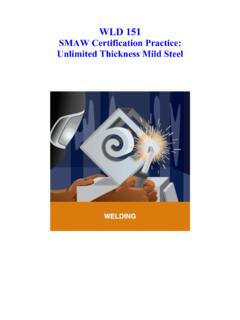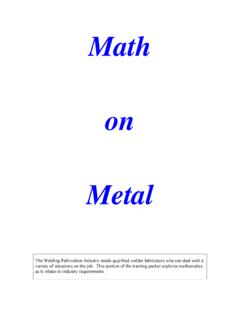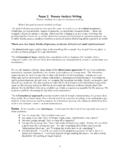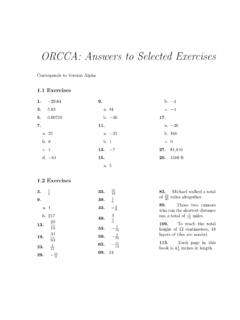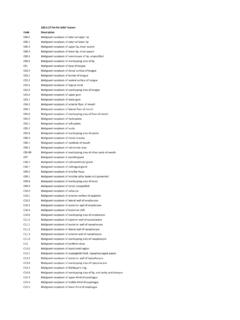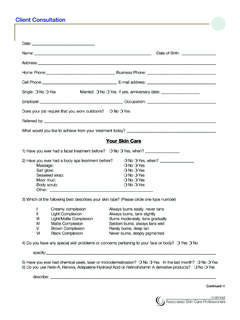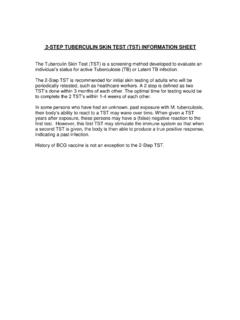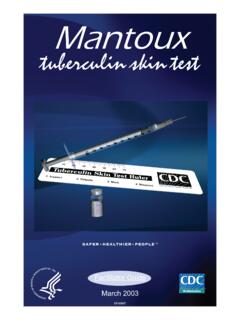Transcription of Practice Quiz Tissues - Portland Community College
1 Tissues & HistologyPractice Lab QuizPress the down arrow key to get the answer and to go to next F5 to StartPortland Community CollegeBI 231 Identify the tissue type and its Squamous Epithelium Diffusion and Filtration Secretes lubricating substances in serosaeIdentify the structure MuscleMultiplePeripherally Located NucleiIdentify the structure Cell Body Identify the structure Bone (Osseous Tissue)Central CanalIdentify the tissue type and a location where it is Cartilage External Ear EpiglottisIdentify the structure Squamous Epithelium.
2 Basement MembraneIdentify the tissue type and its Cuboidal Epithelium Secretion AbsorptionIdentify the structure Cuboidal EpitheliumBasement MembraneIdentify the tissue type and a location where it is Cuboidal Epithelium Kidney tubules Ovary Surface Ducts and secretory portions of small glandsIdentify the tissue type and a location where it is Squamous Epithelium Kidney glomeruli Air sacs of lungs Serosae Lining of heart, blood vessels and lymphatic vesselsIdentify the structure Bone (Osseous Tissue)Interstitial LamellaeIdentify the structure Squamous Epithelium.
3 NucleusApical ViewIdentify the structure Simple Columnar EpitheliumGoblet CellIdentify the structure Simple Columnar EpitheliumBasement MembraneIdentify the tissue type and its Cartilage Supports and reinforces, resists compressive stressIdentify the tissue type and its Simple Columnar Epithelium Absorption Secretion of mucus, enzymes, and other substancesIdentify the tissue type and a location where it is Simple Columnar Epithelium Lines most of the digestive tract Excretory ducts of some glandsIdentify the tissue type and its Simple Columnar Epithelium Propels mucus by ciliary action Propels Ovum in the Fallopian tubesIdentify the structure Simple Columnar EpitheliumGoblet CellIdentify the tissue type and its Pseudostratified Columnar Epithelium Secretion of mucus Propels mucus by ciliary actionIdentify the structure
4 Pseudostratified Columnar EpitheliumCiliaIdentify the structure Columnar EpitheliumApical SurfaceIdentify the tissue type and a location where it is Columnar Epithelium Ducts of large glands Male s sperm-carrying ductsIdentify the structure Areolar Connective TissueCollagen FiberIdentify the tissue type and its Stratified Squamous Epithelium Protects underlying Tissues in areas subjected to abrasionIdentify the structure Stratified Squamous EpitheliumB MbIdentify the structure Pseudostratified Columnar EpitheliumBasement membraneIdentify the tissue type and a location where it is Stratified Squamous Epithelium Esophagus Mouth VaginaIdentify the structure Stratified Squamous Epithelium Identify the tissue type and a location where it is Stratified Squamous Epithelium Epidermis of skinIdentify the tissue type and its Cuboidal Epithelium Protection and limited secretion and absorptionIdentify the tissue type and its Stratified Squamous Epithelium Protects underlying
5 Tissues in areas subjected to abrasionIdentify the tissue type and its Epithelium Stretches readily and permits distension by urineIdentify the tissue type and its Areolar Connective Tissue Wraps and cushions organsIdentify the tissue type and its Columnar Epithelium Secretion of mucusIdentify the structure Cuboidal EpitheliumBasement MembraneIdentify the tissue type and a location where it is Cuboidal Epithelium Largest ducts of sweat, mammary and salivary glandsIdentify the tissue type and a location where it is Pseudostratified Columnar Epithelium Trachea and most of the upper respiratory tractIdentify the tissue type and a location where it is Tissue Under skin Around kidneys Breasts Yellow bone marrowIdentify the tissue type and a location where it is Epithelium Lines ureters.
6 Bladder and part of the urethraIdentify the structure Areolar Connective TissueElastic FiberIdentify the structure CartilageChondrocyte in lacunaIdentify the structure CartilagePerichondriumIdentify the structure EpitheliumDome shaped apical cellsIdentify the tissue type and a location where it is Areolar Connective Tissue Papillary layer of dermis Hypodermis Around organs Basement membrane of mucous membranes Surrounding blood vesselsBlood VesselIdentify the tissue type and its Tissue Insulates against heat loss Supports and protects organs Reserve fuel sourceIdentify the tissue type and its Irregular Connective Tissue Provides structural strength in areas where tension is exerted in many directionsIdentify the structure TissuePlasma MembraneVacuole containing fat dropletIdentify the structure Regular Connective TissueFibroblast (nucleus)
7 Identify the tissue type and a location where it is Irregular Connective Tissue Reticular layer of dermis Submucosa of digestive tract Fibrous capsules of organs and jointsIdentify the structure TissueNucleus of adipocyteIdentify the structure Regular Connective TissueBundle of collagen fibers running parallel to each the tissue type and a location where it is Regular Connective Tissue Tendons Ligaments AponeurosesIdentify the structure Irregular Connective TissueIdentify the tissue type Irregular Connective TissueIdentify the structure Irregular Connective TissueBundle of collagen fibersIdentify the structure Areolar Connective TissueMacrophageIdentify the tissue type and its Cartilage Maintains structure while allowing great flexibilityIdentify the tissue type and a location where it is Muscle HeartIdentify the structure CartilageElastic FibersIdentify the structure Blood CellIdentify the structure CartilageMatrix.
8 Notice the smooth glassy appearance (elastic cartilage has a Identify the tissue type and a location where it is Cartilage Embryonic skeleton articular surface of long bones nose costal cartilages tracheaIdentify the tissue type and its Transports respiratory gases, nutrients, wastes and other substancesIdentify the tissue type and its Regular Connective Tissue Provides strong attachment between structures that have forces pulling in one directionIdentify the tissue type and a location where it is Bone Tissue Epiphysis of Long bones Dipole of Flat bonesIdentify the structure CartilageChondrocyte in lacunaIdentify the structure MuscleStriationsIdentify the structure.)
9 PlateletIdentify the tissue type and its Tissue Transport electrical signals Identify the structure Muscle and Nervous Tissue Motor End PlateIdentify the structure Blood Cells Identify the tissue type Connective TissueIdentify the structure MuscleIntercalated discIdentify the tissue type and a location where it is Tissue Brain Spinal Cord NervesIdentify the structure Blood CellIdentify the tissue type and its Muscle Voluntary MovementIdentify the tissue type and its Squamous Epithelium Diffusion and Filtration Secretes lubricating substances in serosaeIdentify the structure MusclePeripherally Located NucleusIdentify the tissue type and a location where it is Muscle Voluntary skeletal muscles attached to bonesIdentify the tissue type and its Muscle Contracts to propel blood through the circulatory systemIdentify the tissue type and its Muscle Propels substances along internal passagewaysIdentify the substance that is located inside these Marrow (Spongy B)
10 Identify the structure MuscleCentrally located nucleusIdentify the structure Bone (Osseous Tissue)Osteocyte in LacunaeCytoplasmic extensions in canaliculiIdentify the structure Squamous Epithelium:Basement membrane/NucleusIdentify the tissue type and a location where it is Muscle Walls of hollow


